This is a Nikkorex F, a 35mm Single Lens Reflex camera produced by Mamiya Optical Co. for Nippon Kogaku starting in 1962. The Nikkorex F was part of Nippon Kogaku’s Nikkorex line which was their first attempt at an entry level line of cameras and was the only one with an interchangeable lens mount. Using a Copal Square focal plane shutter and the Nikon F mount, the Nikkorex F was thought to be a good way to introduce new photographers to the company’s professional Nikon SLR system without the large price tag. Any lenses you bought for the Nikkorex F could be used on a Nikon SLR that you might buy later. The Nikkorex F was also sold as the Nikkor J in some markets. After Nippon Kogaku discontinued the Nikkorex F, Mamiya would license the camera to Riken and Sears, selling it as the Ricoh Singlex and Sears SL11.
Film Type: 135 (35mm)
Lens: 50mm f/2 Nikkor-H coated 6-elements
Lens Mount: Nikon F Bayonet
Focus: 12 inches to Infinity
Viewfinder: Fixed SLR Pentaprism
Shutter: Copal Square Vertically Traveling Focal Plane
Speeds: B, 1 – 1/1000 seconds
Exposure Meter: None
Battery: None
Flash Mount: Coldshoe and M and X Flash Sync
Weight: 995 grams (w/ lens), 790 grams (body only)
Manual: https://www.cameramanuals.org/nikon_pdf/nikon_nikkorex_f.pdf
How these ratings work |
The Nikkorex F was created as a discount option for the Nikon F that would allow people on a tighter budget to get into the Nikon F system. The camera was built for Nippon Kogaku by Mamiya, but had a high level of quality and a modern for the time vertically traveling focal plane shutter with a flash sync speed faster than Nikon’s pro camera. Like it was back then, the Nikkorex F is still a discount option for the Nikon F, and using the exact same lenses, is capable of the exact same kinds of images. | ||||||
| Images | Handling | Features | Viewfinder | Feel & Beauty | History | Age | |
| 2 | 2 | 1 | 1 | 1 | 2 | 20% | |
| Bonus | none | ||||||
| Final Score | 10.8 | ||||||
History
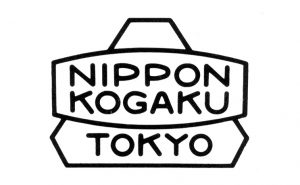 Nippon Kogaku’s history as a world class maker of cameras and lenses goes all the way back to 1917 and is something I’ve covered a number of times on this site. For this camera, we can jump ahead to 1954 when Ernst Leitz released the Leica M3, an all new game changing 35mm rangefinder camera that put the world on notice for what a professional 35mm camera should be.
Nippon Kogaku’s history as a world class maker of cameras and lenses goes all the way back to 1917 and is something I’ve covered a number of times on this site. For this camera, we can jump ahead to 1954 when Ernst Leitz released the Leica M3, an all new game changing 35mm rangefinder camera that put the world on notice for what a professional 35mm camera should be.
When Nippon Kogaku first saw the M3, they knew they had to come up with something special for their next camera, so they got to work putting as many features into what would become the Nikon SP as they could.

Meanwhile, as Nippon Kogaku was preparing their answer to the M3, a change in the preferences of professional photographers was shifting from rangefinders to the Single Lens Reflex. Ihagee had released the 35mm Exakta in 1936 and KW responded both in 1939 and 1952 with the Praktiflex and Praktina.
Although SLRs offered the benefit of through the lens composition, early SLRs had significant downsides, missing features like eye-level viewfinders, an instant return mirror, open aperture composition, and a loud and clunky design. These features were eventually added over the next two decades and by the mid 1950s as more and more German and Japanese companies began to enter the SLR market, Nippon Kogaku knew they would eventually need to release their model.
The biggest challenge they faced in building their first SLR is that Nippon Kogaku was still a very small company and was working out of a single factory in Shinigawa, Tokyo. The amount of physical space afforded to them limited their ability to come up with an entirely new camera, so in order to make the most of their space and budget, Nippon Kogaku’s bean counters put a requirement on the development of a new SLR to use as many parts from the Nikon SP as possible.
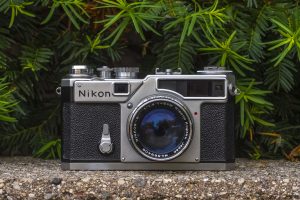
Faced with this challenge, Nippon Kogaku’s engineering and design teams took the body of an SP, elongated it to make room for a mirror box, but otherwise kept as many of the same parts from the SP for their new Nikon Reflex camera as possible. When it was completed, apart from the mirror box and reflex mirror assembly, a Nikon F and Nikon SP share nearly all the same parts.
When it was released in May 1959, the Nikon F made a huge splash, offering nearly everything professional photographers had demanded of an SLR camera. Demand for the camera was extreme, and within the first year it was in production, Nippon Kogaku could not keep up with simultaneous production of their rangefinders and the Nikon F. Faced with growing demand for more SLRs and a demand by Nippon Kogaku’s primary US importer Joseph Ehrenreich, Nippon Kogaku made the decision to cease further development on new rangefinders and focus nearly all of their capacity on the Nikon F.
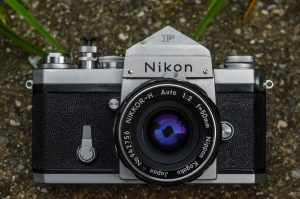
The Nikon F quickly became the preferred choice for the professional photographer as it succeeded in many ways, but that came at a high cost. In 1960, the cost for a base level Nikon F with the standard prism and Nikkor 50mm f/2 lens was $329.50 which when adjusted for inflation, compares to nearly $2900 today. Option the camera with a faster Nikkor f/1.4 lens or the soon to be released Photomic meter and the price climbed even higher.
Nippon Kogaku had their hands full with orders from professional photographers all over the world, but they only had orders from professional photographers as their cameras were far too expensive for amateurs or those with a smaller budget could ever afford and they knew that in order to keep customers interested, they needed a more cost effective model.
The biggest problem was that once again, Nippon Kogaku’s factories were already maxed out and they could not spare any space or effort in creating an all new, less expensive camera, so they turned to another Japanese company for help. In 1960, Nippon Kogaku would release a new series of entry level cameras under the name Nikkorex who were built by Mamiya Optical Co., Ltd. The name Nikkorex was chosen as it was thought that the name Nikon should be reserved only for the company’s top of the line camera and having a lower end model sharing the same name would somehow dilute the brand.
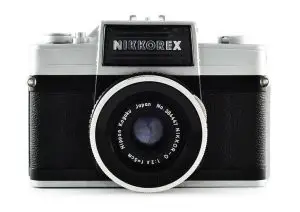
The first model, called the Nikkorex 35 was a simple camera with a Citizen leaf shutter, coupled selenium exposure meter, and a fixed 50mm f/2.8 Nikkor-Q lens. Although featuring an eye level viewfinder, it used mirrors instead of a pentaprism to keep costs low, and lacked other features like an instant return mirror and auto exposure. Since the lens was fixed to the body, there was no way to change it, however two screw on wide angle and telephoto auxiliary lenses were produced which altered the focal length to an equivalent 38mm and 90mm respectively.
In my research for this article, I could not find any conclusive evidence of who actually designed the camera. Did Nippon Kogaku come up with the demand and tell Mamiya to build it, or was this done entirely in house by Mamiya and simply given a Nippon Kogaku name. Most sites theorize one of those two options, but for me, my best guess is that Mamiya probably designed the camera and simply sold it as a Nippon Kogaku. For one, the camera in no way resembles anything Nippon Kogaku had ever made before, the company had no experience with leaf shutters, and frankly, they probably didn’t care what it looked like, as long as they could sell it.
The Nikkorex 35 was produced for two years at which time it was updated as the Nikkorex 35|2 with an all new Citzen shutter and other reliability improvements. In 1963 and 1964 two more cameras, both based on the Nikkorex 35|2 were released, the first with a Nippon Kogaku designed 43-86mm f/3.5 zoom lens, and the second with a pentaprism viewfinder and shutter priority auto exposure. The auto exposure camera was called the Nikkorex Auto 35 and would be the last in the Nikkorex line and was only produced for about a year. An interesting fact is that some versions of the Auto 35 were sold as the Nikon Auto 35, making the first appearance of the name “Nikon” outside of the Nikon F.
The entire Nikkorex lineup sold modestly well, helping Nippon Kogaku gain a little bit of brand recognition outside of the professional photography circles, but it was a closed system camera with no clear upgrade path to more expensive Nikons. If you bought a Nikkorex and eventually wanted to upgrade, there was no real incentive to consider Nikon compared to a growing number of less expensive SLR alternatives out there.
To address this lack of an upgrade path, in 1962 an entirely new camera would be released, also built by Mamiya for Nippon Kogaku, and also sharing the Nikkorex name. The Nikkorex F had an entirely new body, featuring a Copal Square vertically traveling focal plane shutter and the Nikon F interchangeable bayonet mount which meant that most lenses made for the Nikon F could be used on it. Since the Nikkorex lacked a mirror-up feature, some wide angle and fisheye Nikkor lenses could not be used. If a photographer was interested in the Nikon F system, but wanted a more affordable entrance point, the Nikkorex F would get them a body and lens system that could be retained if they wished to upgrade to the pro level Nikon F.
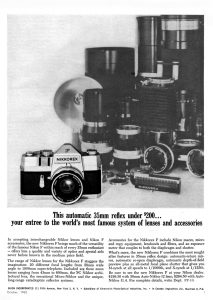
Compared to the $329.50 price for a Nikon F, the Nikkorex F was a bargain with a 50mm f/2 Auto-Nikkor lens at $199.50. For that money, you not only gained an upgrade path to the Nikon F, but the Nikkorex F actually improved on the Nikon F with a faster 1/125 second flash sync speed, and a brighter and faster depth of field preview feature.
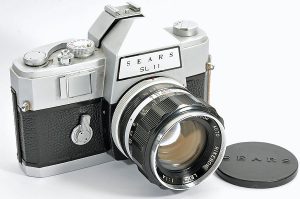
The Nikkorex F was the closest thing Nippon Kogaku had to a mid-level camera until 1965 when the Nikkormat FT was released. With the Nikkormat, Nippon Kogaku finally took on the construction of their camera in house and ended their camera-building partnership with Mamiya. After whatever contract between Nippon Kogaku and Mamiya ended, Mamiya would sell the design of the Nikkorex F to Ricoh, selling a re-branded model with the Nikon F-mount as the Ricoh Singlex and a version sold by the American department store chain Sears, Roebuck, & Co. as the Sears SL 11.
Today, the Nikkorex was but a small blip in the massive success that Nippon Kogaku (later Nikon) would enjoy over the next several decades. Nikon SLRs would be the preferred choice for professional photographers all over the planet, and in outer space. The Nikkorex F itself is hardly discussed as a recommended choice by collectors or those looking to get back into film likely due to its obscurity, but if you happen to come across one in good operating condition, they can be every bit as capable as any other Nikon F-mount camera.
My Thoughts
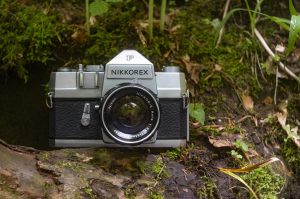
The Nikkorex F was built by Mamiya as an entry level alternative to the Nikon F, which was at the time the world’s standard for a professional 35mm SLR. Even before the Nikon F hit the market, Nippon Kogaku had earned a reputation as a quality maker of cameras and lenses, so upon hearing that Nippon Kogaku was outsourcing production of their new camera to another company, there was likely some concern as to the quality of the new model.
Having handled many Nikon, Nikkormat, and Nikkorex cameras, I can say that the Nikkorex F was very deserving of it’s role as an “entry level Nikon F”. Mamiya did an excellent job of making a solid and easy to use camera that did justice to the Nikon F System.
With a weight of 790 grams, the body of the Nikkorex F is exactly 100 grams heavier than the Nikon F, and is also taller in height by a small amount making the Nikkorex the more physically imposing of the two. Combined with the same lens mount, a new Copal Square shutter with a top 1/125 flash sync speed, and improvements to the viewfinder, the Nikkorex was likely a compelling second camera for the Nikon F user.
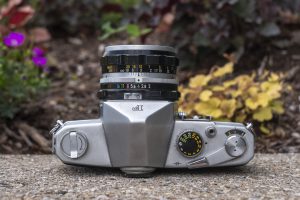
The top plate is ordinary enough that its controls should feel pretty familiar to anyone whose used a 1960s SLR, even if it doesn’t look exactly like that from the Nikon F. From left to right, there is the rewind knob with flip out handle, fixed pentaprism, shutter speed dial, cable threaded shutter release, automatic resetting exposure counter, and film advance lever. Unlike the Nikon F, there is no provision for electronic flash around the rewind knob, nor is there a hot shoe, so your only flash options require either an off body flash, or one added to the front accessory clip.
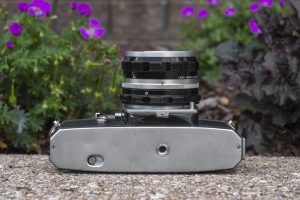
There’s not much to see on the camera’s bottom, with only the rewind release button and centrally located 1/4″ tripod socket. Like the Nikon F, the tripod socket is integrated into the camera’s chassis for added strength.
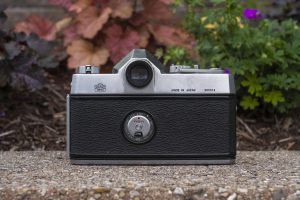
The back of the camera has a circular film reminder dial in the center of the door. The viewfinder has a circular eyepiece that is removable and fits the back of the Nikon F’s standard prism, which suggests that the same number of diopters and other accessories for the Nikon F would fit this camera, although the Nikkorex’s user manual does not make mention of this.
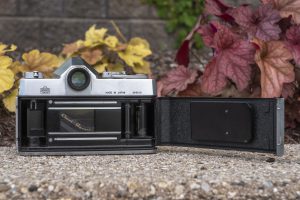
In what might have seemed like an upgrade to some, the Nikkorex has a hinged back, unlike the completely removable back of the Nikon F. A latch on the camera’s left is used to unlock the right hinged door.
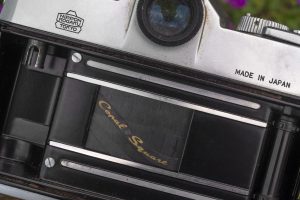
For anyone whose never seen the film compartment of the Nikkorex F, the first thing that likely jumps out at you is the silk screened gold “Copal Square” logo printed onto one of the shutter arms. Although Copal Square shutters would be used in a large number of other cameras made over the next couple of decades, it is not usual to see a logo like this.
Film loads ordinarily from left to right onto a fixed take up spool. A yellow arrow on the spool indicates that it rotates clockwise. The film pressure plate is large, covering nearly the entire film gate, and is divoted, which is done to help reduce friction as film passes over it.
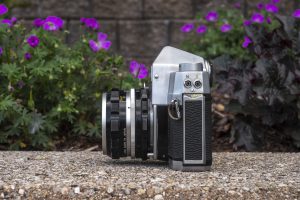
The camera’s left side is where you’ll find the door release for the camera back, and both the M and X flash sync ports. There were two flashes developed specifically for the Nikkorex, but any off body flash could be used by mounting it to the tripod socket on the bottom of the camera.
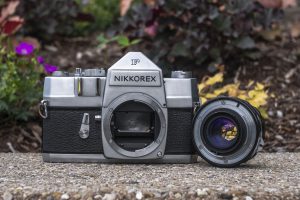
Up front we get a look at the Nikkorex’s best feature, the Nikon F bayonet lens mount. The mount is physically the same as those found on the Nikon F, but one minor difference is the location of the release pin, which instead of being a button near the 3 o’clock position is located closer to the bottom of the camera, near the 5 o’clock position. The Nikkorex lacks a mirror up function which means that some Nikkor fish eye lenses can’t be used as they obstruct the mirror, but has a depth of field preview lever and a mechanical self timer, both to the left of the lens mount. Above the self timer lever is an accessory clip that could be used with one of the Nikkorex’s available flashguns, or the Nikkorex exposure meter.
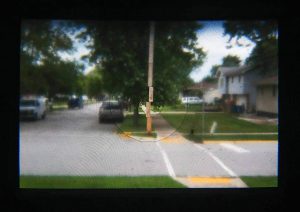
The viewfinder is large and bright, featuring both a split image and ground glass focus aides. The rest of the focusing screen has a strong Fresnel pattern radiating out towards the edges. This has a positive effect on brightness, especially near the corners, but can be distracting to those who don’t like to see Fresnel patterns. Another positive for the viewfinder is that the Nikkorex F supports both open aperture composition and has an instant return mirror, which at the time this camera first hit the market, wasn’t yet a universal feature on SLRs.
The Nikkorex F is a well laid out camera that while having a few differences from the Nikon F, is not different enough that a photographer couldn’t go back and forth between both cameras without having to adjust how they use it. With the exception of interchangeable viewfinders and the ability to connect a motor drive, there isn’t much else that you can’t do with this camera.
My Results
For my first roll through the Nikkorex F, I chose my all time favorite black and white film, Kodak Panatomic-X. This is a film that seems to defy age as every roll I have ever picked up has produced consistently nice shots at or near box speed, regardless of how old the film was. I’ve shot Pan-X expired in the 70s, 80s, and 90s and it always turned out great. I figured using the Nikkorex with Nikkor lenses and my favorite film should return some pretty great images. Despite all of the images in this article showing the camera with a Nikkor-H 50mm f/2 lens, the one I shot this entire roll with was a Nikkor-S 35mm f/2.8 lens.
Looking at the results of the Nikkorex F, there’s little I can say about the images as they were shot through a Nikkor lens which would likely look the same, whether mounted to a Nikkorex F or a Nikon F6.
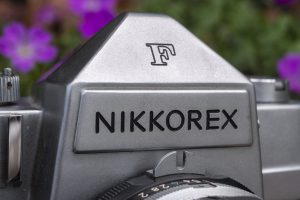
Where I have more to say is in what’s behind those lenses. The Nikkorex line represented Nippon Kogaku’s first attempt at an entry level camera. The target customer of a Nikkorex F was someone who might later want to upgrade to the full Nikon F system while building up lenses prior to investing fully with a body.
With that goal in mind, the Nikkorex F was a huge success. Although using an early example of it, the Copal Square shutter would prove to be very popular and reliable. With a flash sync speed of 1/125, the Nikkorex F was actually more useful for flash photography than the much more expensive Nikon F that was limited to 1/60.
The camera is heavy and a little bit taller than a Nikon F, but the ergonomics are still really good. The viewfinder is bright and very easy to compose through. You have all the modern conveniences of a 1960s SLR such as a Fresnel focusing screen to improve brightness, open aperture composition, and an instant return mirror. When mounted with a quality Nikkor lens, there is nothing about the body that would get in the way of making quality photographs. Professional photographers from the early 1960s might have scoffed at an entry level Nikon made by someone else, but when found in good condition, the Nikkorex F is every bit as capable of a photographic tool as the Nikon F.
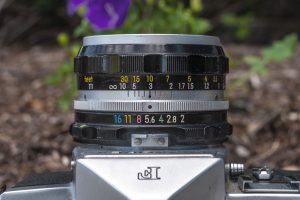
Sure, it lacks support for interchangeable viewfinders, mirror lock up support for fish eye lenses, or a motor drive coupling, but for a straightforward vessel for using Nikon lenses to make images, shooting with the Nikkorex F is so good, it brings me to one of the camera’s biggest cons. I have to wonder if at least a few pro photographers had their introduction to the Nikon F system with one of these cameras and was so impressed by the Nikkorex F that they stopped there. Perhaps Nippon Kogaku’s biggest competition was themselves?
Whether you’re in the market for a mechanical 1960s SLR, or just like collecting things with Nippon Kogaku logos on it, the Nikkorex F is a worthy addition to your collection. This is the only Nikkorex with a focal plane shutter, as all others in the Nikkorex family had a leaf shutter which has a higher rate of failure, so assuming the camera has been taken care of throughout its life, there’s a good chance you should be able to find one in working order.
Related Posts You Might Enjoy
External Links
http://camera-wiki.org/wiki/Nikkorex_F
https://imaging.nikon.com/history/chronicle/cousins03-e/index.htm
https://www.cameraquest.com/nfrex.htm
http://herron.50megs.com/prismat.htm#Nikko
http://www.mir.com.my/rb/photography/companies/nikon/htmls/models/htmls/slr5965.htm


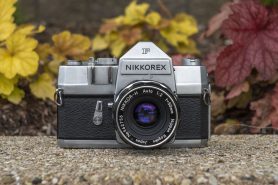
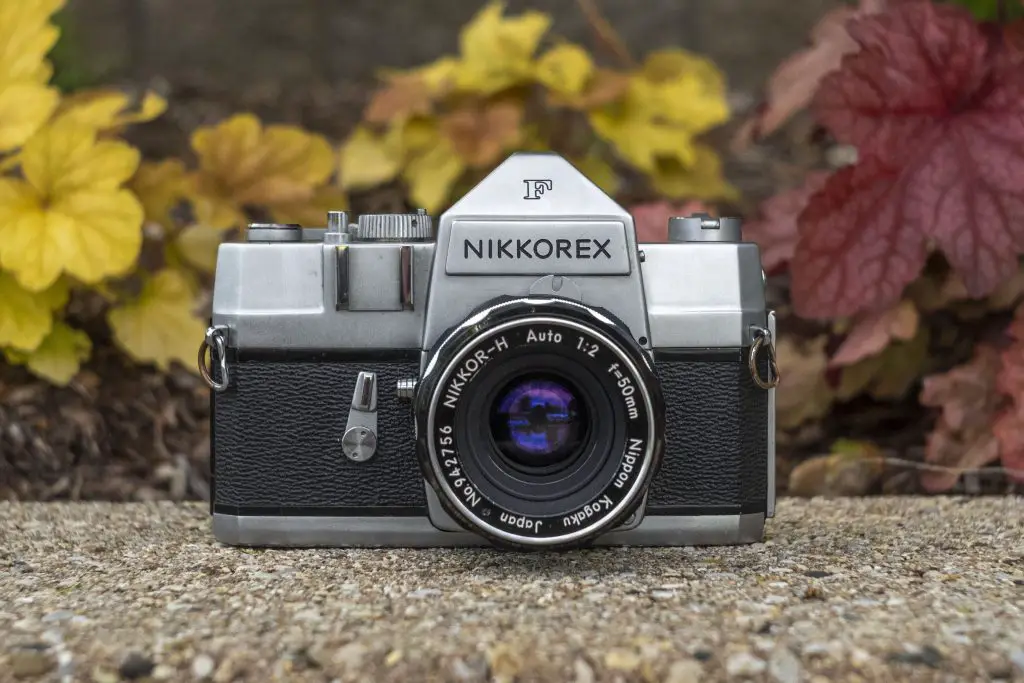
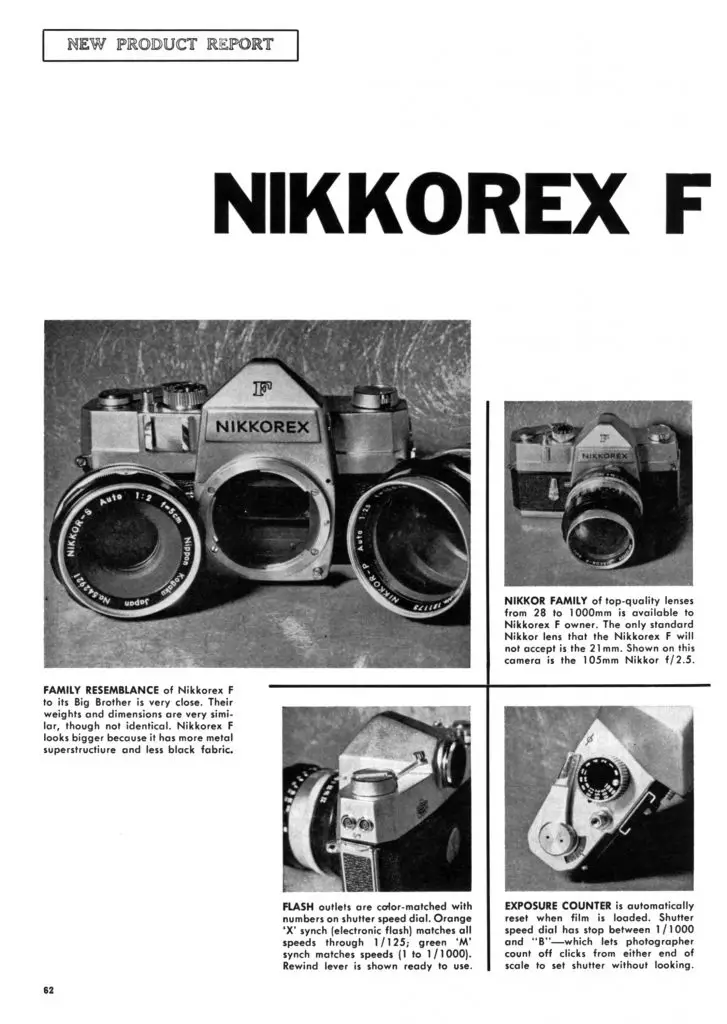
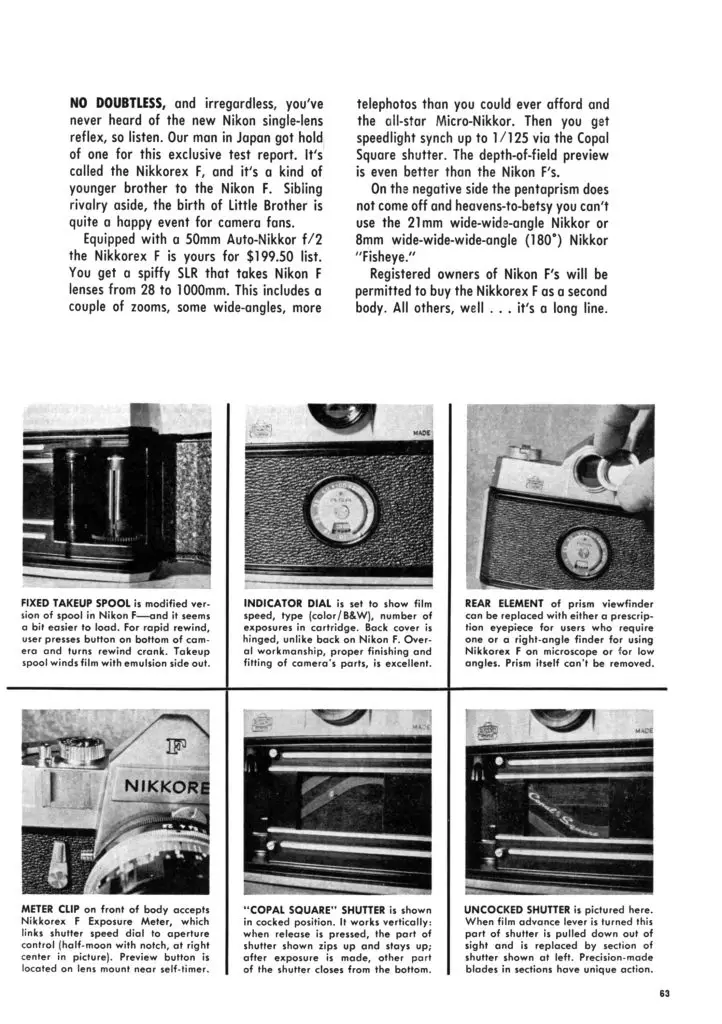











The second version of the Nikkorex 35 came with a Seikosha SLV shutter. It proved to be no more reliable then the Citizen shutter. Did you mention the semi-automatic lenses that Mamiya made in the F mount for the Nikkorex F?
Copal Square metal shutters are remarkably reliable, based on my experiences with many models and brands of camera designed around them. Thanks for this informative article.
I just obtained one of these, with a working accessory meter.
Does anyone know where I can find a manual for the meter?
Butkus has the camera manual, but it doesn’t explain much about the meter. Seems like a nice camera.
I just acquired a used, working Nikkorex F and it lacks the “circular film reminder dial” on the back door. Could this be due to my camera being an earlier model or due to a non-OEM repair?